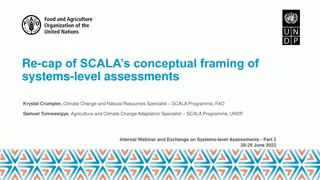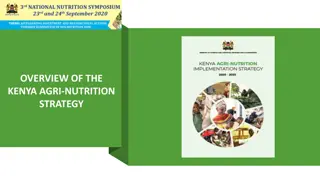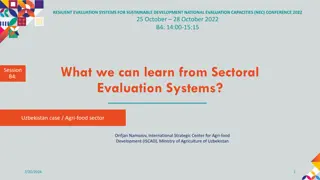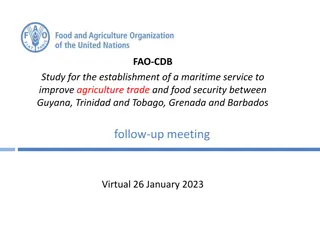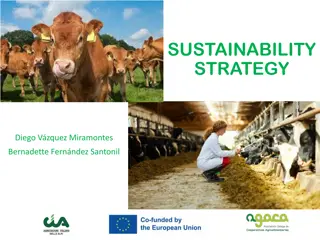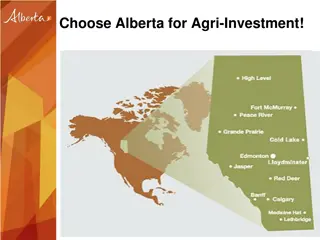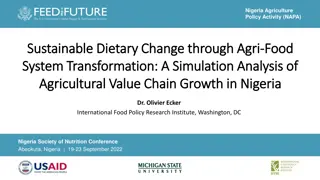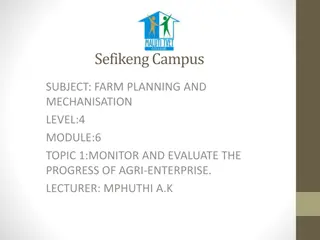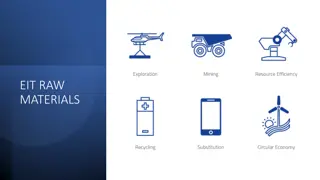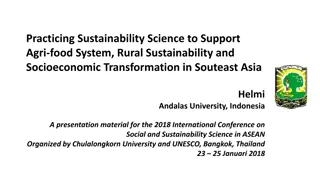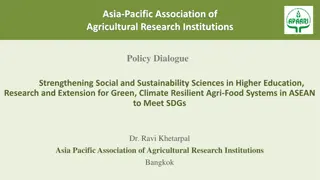CUAB 2327 Agri Technology Management
Agricultural technology, also known as agrotechnology or agtech, is revolutionizing farming practices through the application of modern scientific and technological innovations. Discover the challenges in the agricultural sector and the importance of agricultural technology in enhancing productivity, efficiency, and sustainability. Learn about the benefits of precision agriculture, farm management software, biotechnology, agricultural robotics, vertical farming, smart irrigation systems, and the Internet of Things (IoT) in agriculture.
- agricultural technology
- agrotechnology
- agtech
- precision agriculture
- farm management software
- biotechnology
- agricultural robotics
- vertical farming
- smart irrigation systems
- IoT in agriculture
Download Presentation

Please find below an Image/Link to download the presentation.
The content on the website is provided AS IS for your information and personal use only. It may not be sold, licensed, or shared on other websites without obtaining consent from the author. Download presentation by click this link. If you encounter any issues during the download, it is possible that the publisher has removed the file from their server.
E N D
Presentation Transcript
Agricultural technology, also known as agrotechnology or agtech, refers to the application of modern scientific and technological innovations to enhance agricultural practices and improve productivity, efficiency, and sustainability in the field of agriculture. It involves the development and use of various tools, techniques, equipment, and systems to optimize farming processes, maximize yields, reduce environmental impact, and address challenges in food production. Agricultural technology encompasses a wide range of areas and can include Precision Agriculture, Farm Management Software, Biotechnology and Genetic Engineering, Agricultural Robotics, Vertical Farming and Hydroponics, Smart Irrigation Systems, Internet of Things (IoT) inAgriculture.
Challenges in Agricultural Sector Climate Change rise in temperature Droughts and floods Growth and harvesting of plants Pests and diseases Nutrient composition Loss of biodiversity Land Management Synthetic fertilizers and pesticides Resource depletion loss of forest cover
Importance of Agricultural Technology Farmers no longer have to apply water, fertilizers, and pesticides uniformly across entire fields. Instead, they can use the minimum quantities required and target very specific areas, or even treat individual plants differently. Benefits include: Higher crop productivity Decreased use of water, fertilizer, and pesticides, which in turn keeps food prices down Reduced impact on natural ecosystems Less runoff of chemicals into rivers and groundwater Increased worker safety
In addition, robotic technologies enable more reliable monitoring and management of natural resources, such as air and water quality. It also gives producers greater control over plant and animal production, processing, distribution, and storage, which results in: Greater efficiencies and lower prices Safer growing conditions and safer foods Reduced environmental and ecological impact
Technology Management Aims Technology Management aims at Higher crop productivity Managing the production and processing of agricultural products Decreased use of water, energy, fertilizer and pesticides Reduced adverse affect on natural ecosystem Less runoff chemicals into rivers and ground water Farmer driven / farmer accountable agricultural extension system Increasing the cost of profits and reducing the cost operations Advanced tools, apparatus, equipment's, machines and structures for making farmers effort effective Providing water and nutrients to plants according to their calculated requirement E Commerce system where farmers can sell their products and purchase the other products they need Promoting agri based industries for income and rural employment generation.
Technology Management Objectives To prepare individuals to develop scientific, technical and business skills. To boost productivity with efficient resource utilization at cutting cost. To manage the work force and systems To manage production and operations systems To satisfy on quality control, safety and health issues Bringing working people and technologies together to do what people are expecting To store large amount of data and inventory including customer segmentation To open opportunities for global outreach To build capacity to face market contenders To gain ability to outsource expensive operations to offsite.
Technology Absorption Once a technology is imported from another country, it needs to be absorbed and updated in accordance with the local requirements. Foreign technology may have been developed keeping in view different parameters relating to scale of production, raw materials and components, quality standards, costs, levels and types of production techniques, maintenance requirements, social aspects including environmental and pollution aspects, employment, etc. It is common in many developing countries (such as South Korea, Taiwan, Thailand, Indonesia, Pakistan, Sri Lanka, Bangladesh, Philippines and including our own country) to import technology as a package.
Several of these countries have developed indigenous R&D capabilities of varying order to absorb and upgrade the imported technologies, and to achieve technological self-reliance. While some countries, such as South Korea, Taiwan and Singapore have absorbed technologies predominantly for exports, India has done so predominantly for local markets. The concept of technology absorption differs from country to. country, and even from, firm to firm. In India, absorption is generally considered as the capability to , reproduce or manufacture products according to the "know-how" supplied by the licensor of technology, without really understanding the "know-why" of the technology. In a country like South Korea, know-why exercises to understand the "black-box" of technology have been emphasized at the firm level without which exports are difficult.
Technology Diffusion Technology diffusion is the process by which new technology spreads within a population. Technology diffusion has many different examples, and practices that are used to make it happen. It can be either positive or negative for an individual country s economic development, depending on how well they adapt to the new technologies. Agri - A high rate of technological change is a major feature of modern agriculture. New technologies are introduced gradually; diffusion is the process through which technologies spread throughout the farm sector over time. While adoption is the decision by an individual producer to use a new technology at a given moment, diffusion is the aggregate measure of adoption decisions.
Technology diffuses through four channels: invention, innovation, imitation, and importation. These channels work together to increase awareness of technological innovations to spread their use across populations over time. Invention The invention is the first step of technology diffusion. It is a process in which the Technology itself is created. The invention can come from an individual or a group of people. It can be something completely new or an improvement on existing technology. Once the invention occurs, it needs to be patented to protect its intellectual property. Later, the invention will go through a process called innovation where it s improved and made ready for use by society.
Innovation The next step in Technology diffusion is the innovation process. It involves taking an invention and making it practical for use. The inventor will make improvements to their product so that it s ready for society. Imitation Imitation is when other countries see how well the new technology is doing in the country that invented it and they want to start using it too. In some cases, this can lead to healthy competition between countries as each tries to outdo the other with their new technology.
However, it can also lead to a Technology Race , where countries are trying to get their hands on new technology before anyone else does, even if they don t need it. This can be harmful to a country s economic development because they re wasting resources on something that might not help them in the long run. Importation Importation is when a country takes the technology from another country and uses it within its borders. This can be helpful for countries that aren t as technologically advanced as others because they can import the latest technologies and use them to improve their economy. However, there is also a downside to this if a country imports too many technologies, it can become overwhelmed and struggle to keep up with all the changes.
Technology Diffusion Practices 1. Technology Transfer 2. Technology Licensing 3. Organizational Transfer 4. International TechnologyAgreements 5. Technology Embargoes






